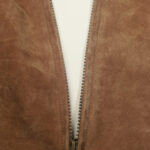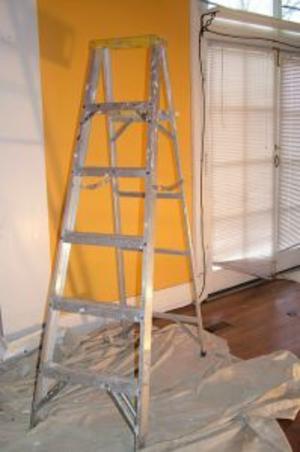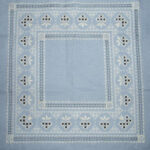Gone are the days when the only choices we had in painting our walls and furniture were between different colors and shines. Now, thanks to glaze mediums, our walls and furniture can take on many faux effects, from crackled, old paint to fabrics like linen and suede. These faux paint treatments can be accomplished in a just a few easy steps that even the novice painter can handle.
Brushed Suede
Brushed suede is a faux painting technique that recreates the look of suede fabric on your walls.
– The first step of the brushed suede faux paint technique is painting the base coat of paint. A roller should be used to apply this coat.
– When the base coat has dried, apply the topcoat of paint with a three to four inch brush, using overlapping X’s that vary in size. Unlike other faux paint techniques, neither a glaze nor a different colored topcoat is used. Instead, the same colored suede paint is used for both coats, like Lowe’s Valspar Signature Colors Brushed Suede paint or Sherwin Williams Illusions Soft Suede paint. Blend the strokes together for a more mottled effect.
Color washing is a faux painting technique that usually uses two or more similar colors to create a subtle, tone-on-tone effect on your walls. However, for a more dramatic effect, opposing colors or a white base coat can be used to make the glaze colors pop.
– To begin color washing, first paint your base coat and allow it to dry. As a general rule, the base coat needs to be a brighter color than the glaze coat so that it can be seen through the glaze. It should also be a satin or semi-gloss finish, as their smoother textures are more glaze-friendly. Glazes tend to stick to the rougher finish of a flat base coat and are therefore less compliant and quicker to dry than when they are applied to a smoother base.
– Once the base coat has dried, you can use either a premixed glaze, a glaze that your local home improvement store has custom-tinted for you, or a glaze that you have mixed yourself to wash your walls with color. If you choose to tint the glaze on your own, now is the time to do it. One common recommendation is to mix one-part paint to five-parts glaze. Another is to mix one-part paint to one-part water and one-part glaze.
– For a softer look, use a sponge or a cloth to apply the glaze in overlapping circular patterns to the wall. For a more textured look, use a color washing brush and overlapping X’s. Be sure to vary the size, intensity, and even direction of the patterns as you go along.
– Allow this first coat of glaze to dry before adding any additional colors.
Crackling
Crackling is a faux painting technique that involves making new paint look old. Most often used on furniture, crackling replicates the effect of age on paint-that is, the notion that a coat of paint cracks over time-and makes your furniture or walls look decades older than they really are. Any combination of colors can be used for the base and top coats.
– As with color washing and the brush suede technique, you must first paint your base coat and allow it to dry. The base coat color will be the color that shows through the cracks of paint.
– Apply the crackling glaze according to the directions on the container, as they may differ from brand to brand. For example, some crackling glazes require that you apply the glaze in only one direction and that you don’t overlap strokes, while other glazes suggest that you apply the glaze in overlapping X’s. Elmer’s Glue or another brand of white school glue may be used in lieu of crackling glaze.
– When the glaze has dried according to the product’s instructions-again, product lines differ and may require that the glaze dry completely or just dry to the point where the glaze is no longer tacky–apply your topcoat, preferably in one direction. The topcoat will crackle in the direction that the glaze is applied. The thicker you apply the topcoat of paint, the larger the sections of cracked paint will be. Crackle size will also vary based on whether you use a paintbrush or a roller to apply the topcoat. A flat-finish paint is recommended.
Dragging
Dragging is a faux painting technique that involves dragging a dry brush through tinted glaze, which, in turn, creates fine vertical lines in the paint’s finish.
– Again begin your faux painting by painting your base coat and allowing it to dry.
– Once the paint has dried, apply your tinted glaze with a roller in small sections.
– Follow the roller with a dry, dragging brush. You should hold the brush parallel to the wall and drag the dry bristles through the glaze so that it removes the glaze in thin, vertical stripes. Keep removing the glaze from the bristles after each pass so that the brush can remain dry and the stripes more uniform.
– Move onto new, small sections until you have painted and dragged the entire area.
– A similar effect can be achieved through a faux painting technique called combing. Follow the same steps, only drag a combing tool instead of a dry brush through the glaze.
Linen Weave
Linen weave is a faux painting technique that recreates the look of linen on your walls. The process is very similar to dragging and combing.
– First, paint your base coat and allow it to dry.
– Next, roll your first coat of glaze on vertically, utilizing small sections of wall like you did with dragging.
– While the glaze is still wet, drag a dry, dragging brush vertically through the glaze. Clean the glaze off the dragging brush with each stroke so that it remains dry. Continue doing small sections of wall until you have dragged the entire area. Then allow the glaze to dry.
– Roll a horizontal coat of glaze onto the wall, again working in small sections.
– Drag the brush horizontally through the glaze, cleaning the brush as you go along.
Rag Rolling
Rag rolling is a faux painting technique that uses rags to either apply a tinted glaze to a wall or to take it off, based on the painter’s preferred method. It is similar to color washing, only a little less subtle.
– With either method, the first step is to paint a base coat of paint and to allow it to dry.
– Once dry, you can do one of two things. One, you can dip a wet rag in glaze and use it to roll the glaze across the wall. Two, you can use a roller to apply a layer of glaze, and then use a dry rag to roll it off. With either method, you may have to switch to a clean rag when the one you are using becomes too saturated with glaze to continue.
– A similar effect can be achieved through a faux painting technique called sponging. The same steps are followed, only a sponge is used instead of a rag.
– You can also substitute a rag roller or a sponge roller for the rags and sponges. For further assistance with faux painting, please visit your local paint or home improvement store.
Sources Cited
Color Washing Your Walls, http://www.lowes.com/lowes/lkn?action=howTo&p;=HomeDecor/ClrWshWalls.html&rn;=RightNavFiles/rightNavHowTo.
Combing, http://www.sherwin-williams.com/pdf/faux_finishing/combing.pdf.
Crackle, http://www.sherwin-williams.com/pdf/faux_finishing/crackle.pdf.
Decorative Paint Techniques: Colorwashing, http://www.hgtv.com/hgtv/dc_faux_colorwash/article/0,1793,HGTV_3396_4470346,00.html.
How to Crackle Finish, www.alsnetbiz.com/homeimprovement/crackle.html.
Liven Up Your Walls with a Colorwash, http://www.hgtv.com/hgtv/dc_faux_colorwash/article/0,,HGTV_3396_3585157,00.html.
Paint Technique: Colorwashing, http://www.hgtv.com/hgtv/dc_faux_colorwash/article/0,1793,HGTV_3396_3622791,00.html.
Ragged Walls without the Drag, http://www.hgtv.com/hgtv/dc_faux_ragging_parchment/article/0,1793,HGTV_3402_3450449,00.html.
Soft Suede, http://www.sherwin-williams.com/pdf/faux_finishing/softsuede.pdf.
Valspar Faux Collection: Brushed Suede How-To Guide.
Valspar Faux Collection: Color Washing/Lime Washing How-To Guide.
Valspar Faux Collection: Crackle How-To Guide.
Valspar Faux Collection: Dragging/Linen Weave How-To Guide.
Valspar Faux Collection: Rag Rolling How-To Guide.
Valspar Faux Collection: Sponging How-To Guide.






